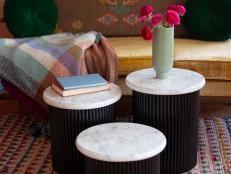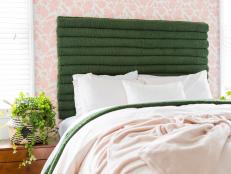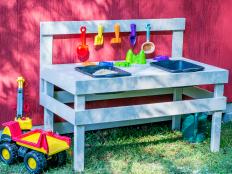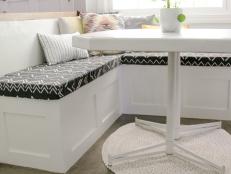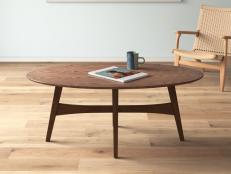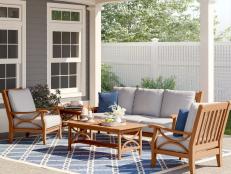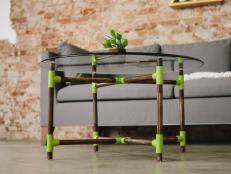How to Make a Wallet-Friendly Pallet Coffee Table
Turn a discarded pallet into a cool, one-of-a-kind piece of furniture.


Sam Henderson
Materials Needed:
- one pallet
- crowbar (optional)
- jigsaw
- carpenter's square
- box saw or table saw
- drill and small drill bit
- 1-1/2" nails
- hammer
- sander and sandpaper
- stain and varnish
- foam brush
- disposable gloves
- steel wool
- (4) 1" galvanized floor flanges
- (4) 1"x12" galvanized pipes
- (4) 1" galvanized pipe caps
- (16) 1" wood screws
Preparing the Pallet
Use a pallet that is sturdy and in good condition. (Image 1) Irregularities will add character, but avoid pallets with slats that are cracked or broken. Clean the pallet by brushing it thoroughly and removing any unwanted nails that may be protruding. Use a jigsaw to cut each slat at each end just before it overlaps the supports. (Image 2) Do not cut the supports as these will be reused. After the outside supports have been released from both the top and bottom slats, use a crowbar or the back of a hammer to carefully remove the slats from the center support. Remove the end pieces and nails from the outside supports. Remove any nails from the slats and the center support. Determine the shortest length of all of the slats. Use that measurement to mark all of the slats with a straight line at each end using a carpenter’s square to keep them even. Cut the ends of each of the slats with a box saw and mitre box or a table saw. (Image 3) Arrange half of the slats together on the floor and measure the width of the boards. Use this measurement to mark and cut the supports.

Sam Henderson
Make a stylish industrial coffee table from an upcycled pallet

Sam Henderson
Make a stylish industrial coffee table from an upcycled pallet

Sam Henderson
Make a stylish industrial coffee table from an upcycled pallet
Assembling the Table Top
Arrange the supports vertically on the floor with one on both ends and one in the middle. Lay half of the slats over the supports and match up the ends and corners to make it as flush as possible. Pallet wood can be quite dry so it is important to pre-drill the holes for the nails. Using a bit that is just a bit smaller than your nails, drill two holes in the ends of each slat and into the supports below on each end of the tabletop. (Image 1) Use these holes to nail the slat securely to the end supports. (Image 2) Position the middle support directly in the center of the tabletop and pre-drill 2 holes in each of the slats and into the middle support. Nail the slats securely to the middle support. Turn the table top over and attach slats to the other side in the same way.

Sam Henderson
Make a stylish industrial coffee table from an upcycled pallet

Sam Henderson
Make a stylish industrial coffee table from an upcycled pallet
Finishing the Table Top
Sand the table all over using very coarse sandpaper at first (50 grit) and then progressing to medium (150 grit) and fine (220 grit) if you prefer. (Image 1) Tip: Keep in mind the more the project is sanded, the less patina it will retain. Dust the table top with a brush and wipe with a damp cloth to remove any excess saw dust. Apply stain and varnish allowing the table top to dry completely after applying each coat. (Image 2) Apply a second coat of varnish, if desired. After varnish is completely dry, lightly rub the table top with steel wool, in the direction of the grain of the wood, to remove any roughness. Wipe with a lightly dampened cloth to remove dust.

Sam Henderson
Make a stylish industrial coffee table from an upcycled pallet

Sam Henderson
Make a stylish industrial coffee table from an upcycled pallet
Adding the Legs
Lay the table top on a flat surface with the bottom side up. Attach one floor flange in each of the four corners of the bottom of the table top using 1” wood screws. Attach a 12” pipe to each of the floor flanges. Cap each pipe with a galvanized pipe cap. Turn the table over and use the pipe caps to level the table as necessary by tightening or loosening them. Leave the openings in the table empty or fill them with magazines or serving trays. NOTE: Pallets vary slightly, so it is impossible to give exact measurements here. Follow the directions closely, and note the measurements on a piece of paper as you proceed. This project produced a table which is 18-1/4 inches tall. If a taller table is needed based on the cushion height of the sofa, change the length of the pipes to account for the difference.

Sam Henderson

Sam Henderson

Sam Henderson






